Lower back pain is one of the most common physical ailments among adults, affecting millions of people worldwide. Whether it stems from prolonged sitting, improper lifting techniques, injury, or underlying medical conditions, chronic lower back pain can severely impact quality of life and physical independence. Fortunately, there are effective strategies that don’t require a clinic or a gym. Physical therapy for back pain has evolved to include evidence-based exercises and stretches that can be performed right at home, with little to no equipment. These exercises are not only designed to ease discomfort in the moment but also to promote long-term resilience, flexibility, and spinal health. In this comprehensive guide, we explore expert-backed physical therapy exercises for lower back pain that target both acute discomfort and chronic strain, all while emphasizing proper form, safety, and sustainable results.
You may also like : Best Stretches for Sore Legs and Tight Thigh Muscles: How to Relieve Upper Leg Pain Safely and Naturally
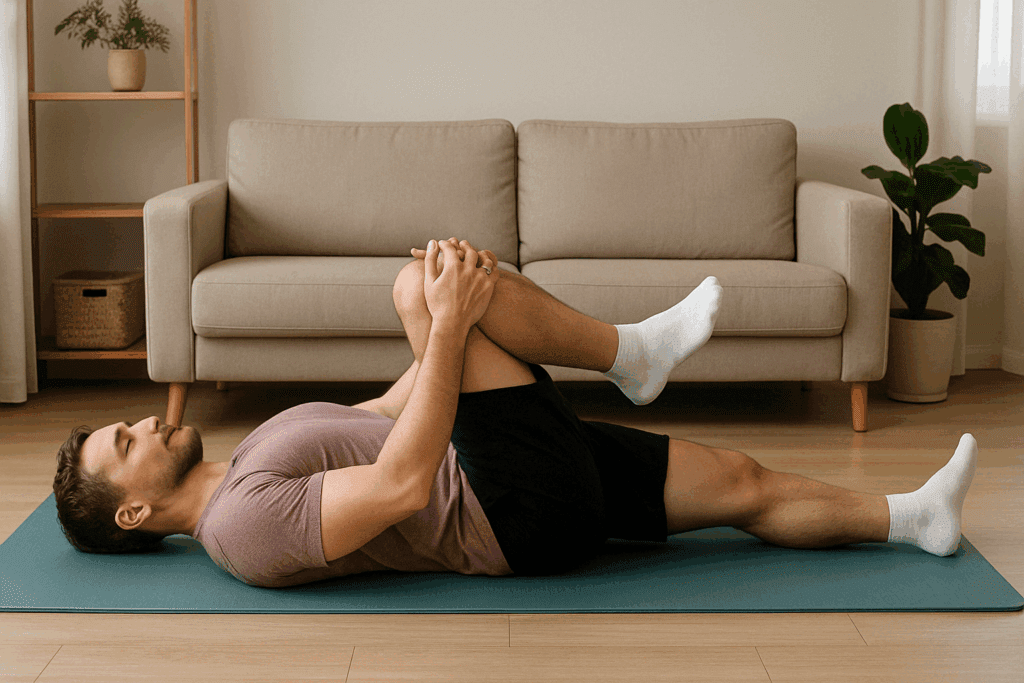
Understanding the Role of At-Home PT for Lower Back Pain
For individuals managing ongoing discomfort in the lumbar region, the concept of at-home PT back routines offers both accessibility and effectiveness. Lower back physical therapy exercises are specifically crafted to reduce tension, restore functional mobility, and strengthen stabilizing muscles around the spine and pelvis. A well-structured at-home program can be just as beneficial as in-office treatments when guided by evidence-based principles and individualized attention to posture, core strength, and flexibility.
One of the key components of successful lower back physiotherapy exercises for pain is consistency. Unlike sporadic gym sessions or occasional stretching, an at-home PT plan integrates daily or near-daily movement that retrains the body and fosters muscle balance. Physical therapy for lumbar pain often emphasizes motor control, gradual loading, and neuromuscular re-education, all of which can be achieved without expensive equipment. Whether someone is recovering from a lumbar strain or seeking long-term relief, incorporating back physical therapy exercises into a home routine empowers individuals to take control of their healing journey.

The Neurological Dimension of Lower Back Pain and PT Exercises
Modern neuroscience has revealed that chronic lower back pain is not solely a mechanical issue; it often involves complex interactions between the nervous system and musculoskeletal structures. Persistent pain can lead to maladaptive neuroplastic changes, meaning the brain may become hypersensitive to pain signals even after tissue healing has occurred. For this reason, physical therapy for back problems must sometimes include interventions aimed at calming the nervous system.
At-home PT back routines can incorporate gentle nerve-gliding techniques, mindfulness-based movement, and graded motor imagery to help retrain the brain’s perception of movement and pain. Exercises such as supine leg slides, nerve flossing for the sciatic nerve, and eye-head coordination drills have been shown to enhance neural mobility and reduce central sensitization. When combined with traditional lower back PT, these methods create a holistic strategy that supports both tissue healing and neurophysiological restoration.
Postural Habits and Ergonomics in the Context of At-Home Physical Therapy
One of the lesser-emphasized but critically important aspects of back physical therapy is the role of posture throughout the day. Poor sitting posture, unsupported standing positions, and awkward sleeping arrangements can perpetuate lower back discomfort even when consistent PT stretches for lower back are performed.
A comprehensive approach to at-home physical therapy for lower back pain must therefore include ergonomic education. This might involve adjusting the height of a work desk, using a lumbar roll during sitting, elevating a laptop screen to eye level, or sleeping with a pillow between the knees to maintain spinal alignment. Additionally, taking microbreaks every 30 minutes to stand, stretch, or walk can prevent cumulative strain. By aligning everyday posture with therapeutic goals, patients amplify the effectiveness of their physical therapy workouts for lower back relief.
The Benefits of PT Exercises for Lower Back Pain
Physical therapy for back pain addresses the multifaceted nature of lumbar discomfort, which may originate from muscle imbalances, degenerative changes, nerve compression, or poor ergonomics. The advantage of pt exercises for lower back issues is that they target these root causes rather than simply masking symptoms. By strengthening core and pelvic musculature, improving posture, and enhancing spinal mobility, individuals often experience significant pain reduction and functional improvement.
Another important benefit of lower back PT is its ability to prevent recurrence. Many people who suffer from lower back injuries experience repeated episodes unless preventative strategies are put in place. Lower back pain PT exercises can act as both rehabilitation and a proactive defense against future problems. Furthermore, physical therapy workouts for lower back issues contribute to psychological well-being. Movement and exercise are known to release endorphins, reduce anxiety, and help patients regain confidence in their physical capabilities. Over time, this contributes to a more active, independent lifestyle.
How Physical Therapy for Strained Lower Back Differs from General Fitness
It is critical to distinguish physical therapy for strained lower back conditions from general fitness routines. While fitness workouts may include core or stretching components, PT for back issues is tailored to specific musculoskeletal needs. Physiotherapy techniques for back pain are guided by an understanding of spinal biomechanics, pain mechanisms, and functional goals. Unlike general workouts, which may risk aggravating an injury, a pt lumbar exercise regimen focuses on gradual progression, pain-free movement, and corrective alignment.
For instance, a patient recovering from a lumbar disc herniation might engage in McKenzie-based exercises or pelvic tilts to centralize symptoms and reduce neural tension. Someone with muscle tightness may benefit more from lower back physiotherapy exercises for pain that involve static stretches and trigger point release. The key is individualized programming that considers a person’s anatomy, history, and symptoms. Physical therapy for back problems integrates diagnostic expertise with therapeutic movement, creating a holistic approach to healing that general exercise does not offer.
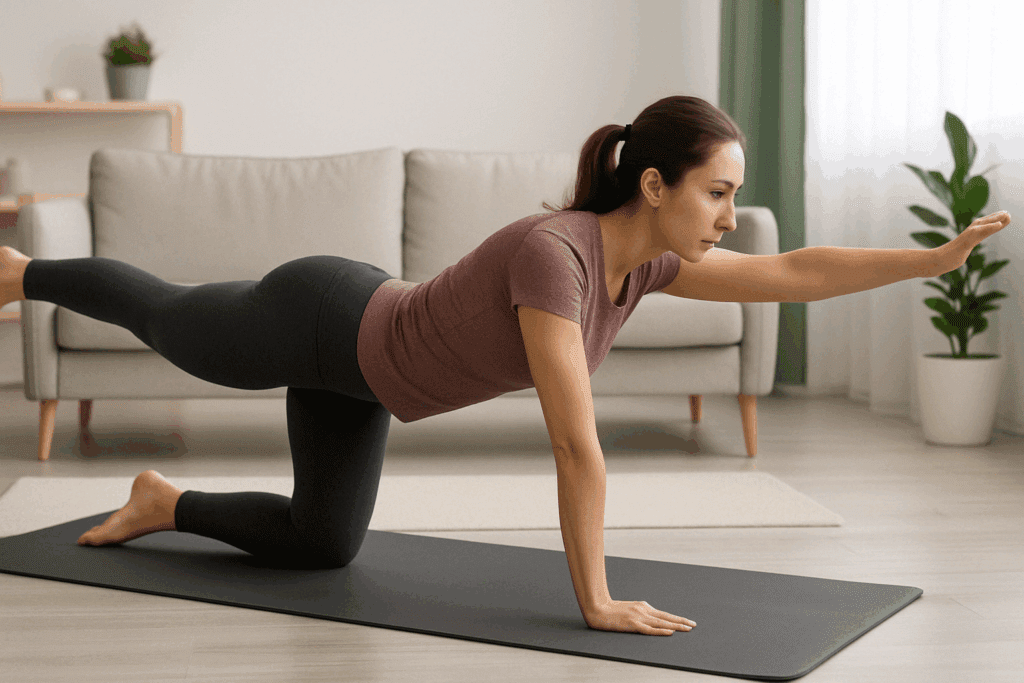
Core Engagement and Stability: The Foundation of PT for Back
At the heart of effective lower back PT is the principle of core stabilization. The deep abdominal and spinal muscles serve as dynamic stabilizers that support the vertebral column during movement and load-bearing activities. When these muscles are weak or poorly activated, it places excessive strain on passive structures like ligaments, discs, and joints. PT back exercises therefore emphasize not only the engagement of surface muscles but also the activation of deep core units such as the transverse abdominis and multifidus.
Many lower back physical therapy routines begin with simple core exercises like abdominal bracing, diaphragmatic breathing, and pelvic tilts. These lay the groundwork for more complex movements by retraining motor control and teaching patients how to move without compensatory patterns. Over time, PT back exercises progress to include functional tasks such as bridges, bird-dogs, and planks. These movements not only strengthen the core but also improve neuromuscular coordination between the hips, spine, and limbs, which is essential for long-term spinal health and back pain prevention.
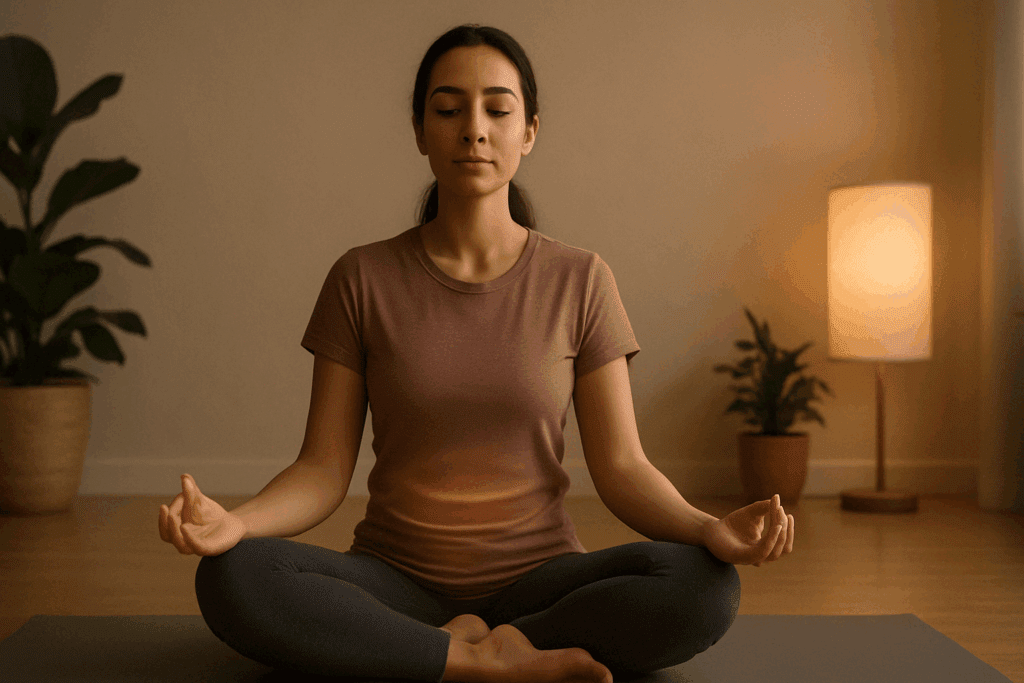
Mindfulness and Breathwork to Enhance PT for Back Recovery
Pain and stress often exist in a feedback loop, where each exacerbates the other. Incorporating mindfulness and breathwork into lower back physiotherapy exercises for pain can disrupt this cycle. Practices such as diaphragmatic breathing, body scanning, and progressive muscle relaxation can activate the parasympathetic nervous system, reducing muscle tension and promoting healing.
Diaphragmatic breathing, in particular, not only calms the nervous system but also supports core activation. This breath-driven engagement of the deep abdominal muscles enhances stability during PT lumbar exercises and facilitates neuromuscular control. Mindful movement practices, such as yoga or tai chi, can also be tailored into PT for back routines to foster body awareness, movement fluidity, and psychological resilience.
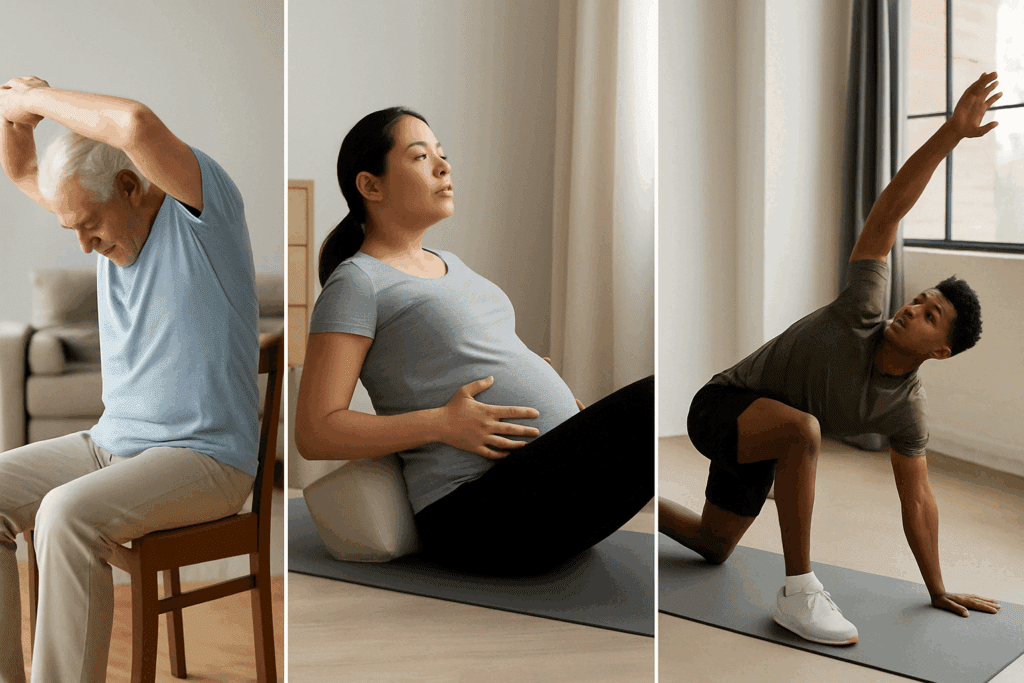
PT Stretches for Lower Back Pain in Specific Populations
Lower back pain affects a diverse array of individuals, and tailoring PT stretches for lower back relief to specific populations can significantly improve outcomes. For older adults, the focus may be on gentle, low-impact movements that enhance balance and reduce fall risk. Physical therapy exercises for back pain in seniors often include chair-based stretches, pelvic tilts, and hip bridges with modifications.
In athletes or highly active individuals, the emphasis may shift toward dynamic stability, eccentric loading, and sports-specific drills. Pregnant individuals experiencing lumbar discomfort may benefit from prenatal PT techniques that reduce sacroiliac joint stress and strengthen the pelvic floor. A one-size-fits-all approach is not effective when dealing with lower back pain PT exercises, making customization based on age, fitness level, and medical history essential for success.
The Role of Sleep in Enhancing Physical Therapy for Back Pain
Recovery from lower back pain relies heavily on quality sleep, yet many people with lumbar discomfort struggle to find comfortable sleeping positions or suffer from sleep disturbances due to pain. Sleep is when the body undergoes tissue repair, immune modulation, and hormonal regulation—all essential for the success of PT exercises for lower back recovery.
Sleep hygiene practices that support physical therapy include establishing a consistent bedtime routine, avoiding screens before bed, limiting caffeine in the afternoon, and using supportive sleep surfaces. Side sleeping with a pillow between the knees, or back sleeping with a small cushion under the knees, can alleviate lumbar strain. By prioritizing sleep health alongside lower back PT routines, patients enhance healing and optimize their body’s capacity to adapt to therapeutic exercises.
Flexibility and Range of Motion: Back Stretches That Support Healing
Stiffness in the lumbar region, hips, or hamstrings can exacerbate lower back pain by altering movement mechanics and increasing mechanical stress on spinal structures. That is why flexibility training is a cornerstone of most physical therapy for lumbar pain programs. PT stretches for lower back health focus on restoring full range of motion to key areas, relieving muscular tension, and improving circulation to promote healing.
Popular stretches used in physiotherapy for back pain include knee-to-chest, cat-cow movements, seated spinal twists, and child’s pose. Each of these stretches targets a different segment of the spine or surrounding musculature. When done consistently and with proper form, these movements alleviate tightness, enhance joint mobility, and reduce the likelihood of strain during daily activities. Physical therapy exercises for back pain often alternate between dynamic and static flexibility to prepare the body for movement while also promoting relaxation and tissue recovery.
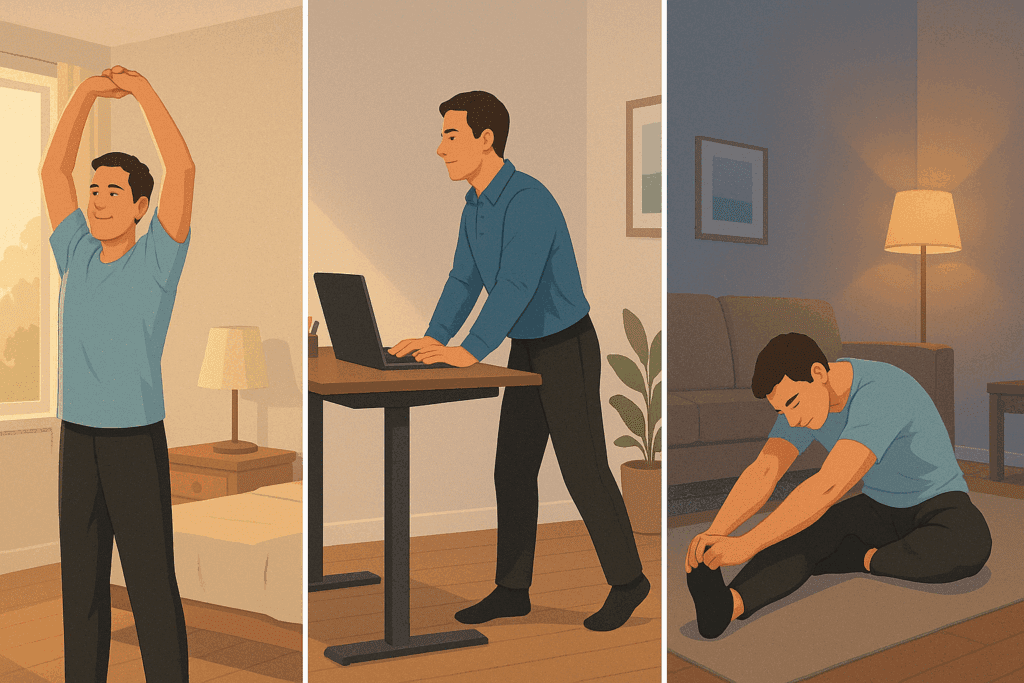
How to Incorporate Physical Therapy Workouts for Lower Back Into Daily Life
Sustainability is one of the most crucial elements in any PT for back routine. It is not enough to perform a few exercises sporadically and expect long-term results. Instead, patients are encouraged to integrate lower back PT into their lifestyle by setting aside consistent time each day for movement and establishing rituals around self-care. This might include doing a short sequence of back physical therapy exercises in the morning, taking movement breaks during sedentary work hours, and performing gentle stretches before bed.
Those using at-home physical therapy for lower back pain should also be mindful of ergonomics and posture throughout the day. Even the most effective PT exercises will fall short if one spends the majority of the day hunched over a desk or lifting heavy items improperly. Many physical therapists offer guidance on workstation setup, proper body mechanics, and movement modifications to complement exercise efforts. When PT lumbar exercises are paired with lifestyle adjustments, the results are not only faster but more enduring.
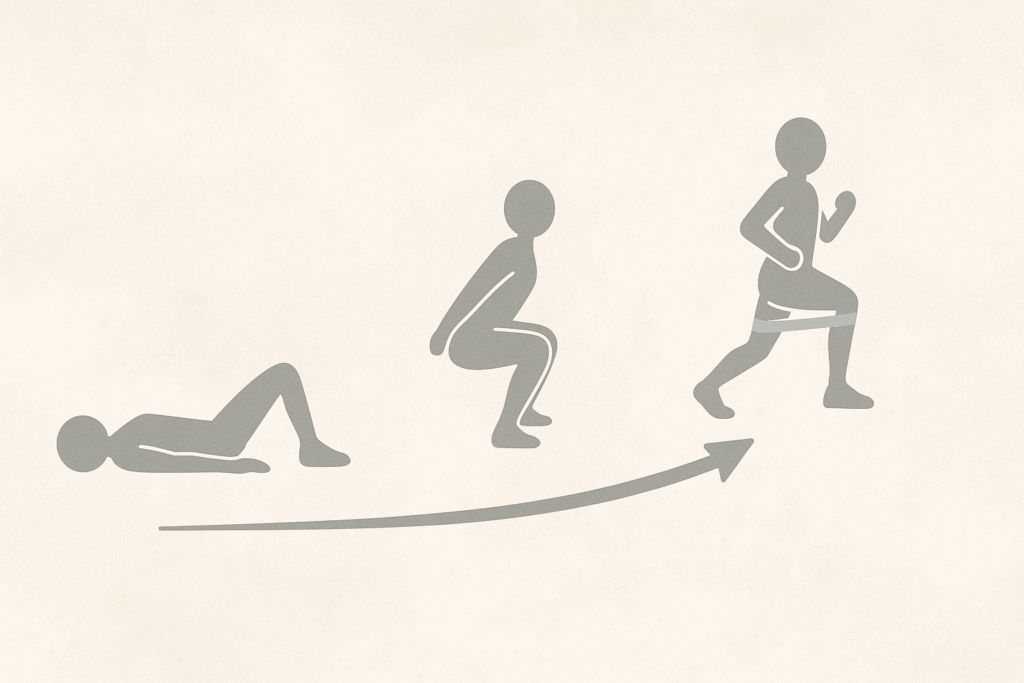
The Importance of Progression in Lower Back Physical Therapy
Healing from back pain is rarely a linear process. It involves ups and downs, and progress often comes in incremental stages. This is why progression is a key principle in physical therapy for back problems. In the early stages, movements may be limited to gentle stretches and isometric holds. As symptoms improve, the exercises should become more dynamic, challenging balance, strength, and endurance.
A well-designed progression plan will include milestones such as transitioning from floor-based to standing movements, increasing resistance using bands or weights, or adding functional activities like squats or lunges. By following this structured advancement, patients avoid plateauing and continue to build resilience. Low back pain physical therapy treatment that includes thoughtful progression reduces re-injury risk and builds the confidence necessary for returning to work, sports, or recreational activities. Physical therapy for strained lower back injuries must evolve with the patient, adapting to their changing needs and goals.
Common Mistakes to Avoid When Doing At-Home PT Back Routines
Although the convenience of home-based therapy is a major benefit, it also comes with the risk of improper execution. One common mistake in at-home PT back programs is performing exercises with poor form. This can actually worsen symptoms or create new areas of strain. It is essential to learn correct technique, ideally through instruction from a licensed physical therapist or a trusted video guide. Recording oneself during exercise and reviewing the footage can also help detect misalignments or compensatory movements.
Another frequent error is neglecting warm-up and cool-down routines. Jumping directly into physical therapy workouts for lower back pain without preparing the muscles can increase the likelihood of stiffness or injury. Patients should begin each session with light aerobic activity or gentle mobility drills to increase blood flow and prime the body for movement. Similarly, ending with slow, controlled stretching helps release tension and facilitates recovery. By avoiding these pitfalls, individuals can maximize the benefits of their back physical therapy exercises.
Digital Tools and Resources: Using PDFs, Apps, and Video for Guided PT
Thanks to advances in technology, patients now have access to a wide array of digital tools that support physical therapy for back problems. For instance, low back pain exercises PDF guides offer printable, step-by-step instructions that can be easily followed at home. These documents often include diagrams, safety tips, and progression charts, making them invaluable for beginners or those without regular access to a therapist.
Mobile apps and video platforms provide further guidance through interactive formats. Some apps allow users to track their progress, set reminders, and watch demonstration videos from licensed professionals. This is particularly helpful for those doing lower back physiotherapy exercises for pain, as it ensures proper form and consistency. However, it is important to choose evidence-based programs and avoid unverified sources. Reputable physiotherapy for back pain should be grounded in science, not just social media trends. Patients are encouraged to consult with their healthcare provider before beginning any new regimen, even if it is self-directed.
When to Seek In-Person Physiotherapy for Back Pain
While many individuals can effectively manage symptoms through at-home PT routines, there are circumstances that require professional intervention. If back pain is accompanied by leg numbness, loss of bladder control, or significant weakness, it may signal a more serious condition such as nerve compression or spinal instability. In such cases, in-person physiotherapy for back pain becomes essential.
A licensed therapist can provide manual techniques, real-time feedback, and advanced diagnostics that are not available through remote methods. They may also collaborate with physicians, chiropractors, or orthopedic specialists to create a comprehensive care plan. For patients with complex conditions, combining in-office visits with at-home PT back exercises provides the best of both worlds: hands-on care and the flexibility of self-management. The goal is to empower patients to eventually become independent with their exercises while ensuring that they are progressing safely.
Frequently Asked Questions: Expert-Level Insights into Lower Back Physical Therapy at Home
1. How can I safely progress from basic to advanced lower back physical therapy exercises without risking reinjury?
Progressing through physical therapy exercises for lower back pain requires a careful balance between challenge and caution. Start by mastering foundational movements with impeccable form, such as pelvic tilts and supine marches, before integrating more dynamic pt lumbar exercises like bird-dogs or resistance band bridges. A key principle is graded exposure: introduce new stressors incrementally to allow the tissues and nervous system to adapt. It’s helpful to use a low back pain exercises PDF as a structured roadmap, ensuring a gradual increase in complexity and volume. When practicing lower back PT at home, track symptoms daily—pain that increases 24 hours after activity may indicate the need to scale back temporarily, while post-exercise soreness that resolves with rest is typically part of healthy adaptation.
2. What role does hydration play in enhancing the results of at-home PT back routines?
Hydration is often underestimated in its importance to physical therapy for back pain, yet it plays a vital role in tissue repair and joint lubrication. Intervertebral discs are composed largely of water, and dehydration can contribute to disc compression and stiffness in the spine. During pt back exercises, microtears in muscle fibers occur naturally and require adequate fluid intake for recovery and nutrient delivery. For individuals following an at-home physical therapy for lower back pain program, especially one involving sustained holds or mobility work, staying hydrated improves fascial elasticity and neuromuscular function. Pairing hydration with back physical therapy exercises supports long-term spinal resilience and reduces injury risk.
3. Are there overlooked psychological factors that impact the success of lower back physiotherapy exercises for pain?
Yes, psychological states such as fear-avoidance, catastrophizing, and low self-efficacy significantly influence the effectiveness of lower back physiotherapy exercises for pain. When individuals fear movement will worsen their condition, they may unknowingly tense muscles or alter biomechanics, undermining the purpose of physical therapy for strained lower back. Incorporating education on pain science, goal setting, and gradual exposure therapy can help patients reframe pain and regain trust in their body. Some evidence-based PT for back programs now integrate cognitive-behavioral therapy (CBT) techniques to enhance outcomes. When combined with physical therapy for lumbar pain, these psychological interventions can dramatically improve engagement, adherence, and long-term relief.
4. How does breathing technique influence the effectiveness of pt exercises for lower back pain?
Proper breathing mechanics, particularly diaphragmatic breathing, enhance the efficacy of pt exercises for lower back by activating deep core muscles like the transverse abdominis. When breath is synchronized with movement, it improves motor control and reduces unnecessary muscle bracing that can contribute to discomfort. This is especially important during back physical therapy exercises that require stability, such as bridges or planks. Incorporating breath-focused sequences into your at-home PT back routine can also reduce sympathetic nervous system overactivation, which is linked to increased muscle tension and pain sensitivity. Breathwork transforms lower back PT from a purely mechanical intervention into a mind-body synergy that supports lasting results.
5. Can wearable technology and smart devices improve the quality of physical therapy workouts for lower back pain?
Emerging technologies, such as posture-correcting wearables and app-connected motion sensors, can offer valuable real-time feedback during physical therapy workouts for lower back. These devices monitor posture, range of motion, and movement quality, helping users refine their lower back PT techniques independently. By identifying compensatory movements or asymmetries, smart wearables can prevent the reinforcement of poor mechanics. Some apps also incorporate backache exercises pictures and instructional videos, enabling users to visualize proper form while following along. For individuals engaging in at-home physical therapy for lower back pain, wearable technology enhances accuracy, boosts motivation, and reduces reliance on frequent in-person sessions.
6. What is the benefit of using visual imagery alongside pt stretches for lower back pain?
Mental rehearsal, or visual imagery, is a neuroscience-backed technique that activates the brain’s motor pathways even in the absence of physical movement. When integrated into pt stretches for lower back, it can enhance neuromuscular coordination, reduce anticipatory fear, and support motor learning. For example, imagining smooth, pain-free spinal motion while performing lower back pain PT exercises can help desensitize overactive pain circuits and increase movement confidence. This technique is especially useful for individuals with limited mobility who may struggle to complete certain back physical therapy exercises due to pain flare-ups. Practiced regularly, mental imagery creates new neural pathways that reinforce the benefits of physical therapy for back problems.
7. How can I optimize my home environment to support my lower back PT routine?
Creating a supportive environment for lower back PT involves more than just clearing floor space. Use props like yoga blocks, cushions, or firm pillows to support neutral spinal alignment during exercises. Consider dedicating a quiet, well-lit area with calming visuals to promote focus and consistency. For those referencing low back pain exercises PDFs, print them and tape them visibly to the wall as a cue and guide. Adjusting the height of chairs, workstations, or even daily-use items like laundry baskets can reduce cumulative strain between sessions. Thoughtful environmental design reinforces healthy biomechanics and supports the goals of lower back physiotherapy exercises for pain management.
8. Are there cultural or lifestyle factors that may affect the efficacy of physical therapy for lumbar pain?
Yes, cultural attitudes toward movement, rest, and pain can significantly influence how individuals engage with physical therapy for lumbar pain. In some communities, there may be stigma around expressing pain or seeking help, while in others, passive treatments may be favored over active rehabilitation. Lifestyle habits such as long work hours, limited access to green space, or dietary inflammation can also impact the body’s response to pt back exercises. Adapting back physical therapy strategies to align with a person’s daily routine, values, and community norms increases adherence and relevance. Culturally competent care ensures that lower back PT protocols are accessible, effective, and empowering across diverse populations.
9. How do nutritional strategies complement physical therapy for back pain recovery?
Nutrition plays a critical but often overlooked role in physical therapy for back pain recovery. Anti-inflammatory diets rich in omega-3 fatty acids, antioxidants, and lean proteins support tissue regeneration and reduce systemic inflammation. Key micronutrients like magnesium, vitamin D, and collagen peptides may also assist in neuromuscular function and connective tissue repair. When combined with pt stretches for lower back and strengthening routines, proper nutrition accelerates healing timelines. For those following a physical therapy workouts for lower back regimen, consider timing protein intake within 30 to 60 minutes post-exercise to support muscle synthesis. This holistic approach integrates nutrition into the broader framework of physical therapy for back problems.
10. What are some reliable ways to evaluate the effectiveness of an at-home physical therapy program for lower back pain?
To evaluate the success of at-home PT back programs, it’s important to use both subjective and objective measures. Track pain levels using a consistent scale (e.g., 0 to 10) alongside qualitative notes on stiffness, sleep quality, and daily function. Objective measures may include improved flexibility (e.g., fingertip-to-floor distance), increased endurance during PT lumbar exercises, or enhanced balance and gait. Periodic assessments with a healthcare provider or by referencing progress benchmarks in a low back pain exercises PDF can help identify plateaus or red flags. Most importantly, success is defined not just by symptom reduction, but by restored confidence in movement, return to meaningful activities, and reduced reliance on passive coping strategies.
Conclusion: Embracing Physical Therapy for Long-Term Lower Back Relief at Home
Physical therapy for lower back pain is one of the most effective, research-backed methods for managing and overcoming lumbar discomfort. The beauty of today’s approach is that it no longer relies solely on clinical visits or expensive equipment. With the right guidance, lower back physical therapy can be done entirely from home, offering patients a sense of control, convenience, and confidence. Through a thoughtful combination of strength-building, stretching, and movement re-education, PT exercises for lower back pain address not only the symptoms but the root causes.
From core stabilization and posture correction to flexibility training and progression planning, at-home PT back routines are a comprehensive solution for a wide range of individuals. Whether you’re dealing with a minor strain or a chronic condition, physical therapy workouts for lower back issues allow for incremental healing and long-term prevention. By incorporating lower back physiotherapy exercises for pain into your daily habits and using tools like low back pain exercises PDF guides or mobile apps, you can create a sustainable path to spinal health. In doing so, you not only relieve existing pain but also lay the foundation for a stronger, more resilient future—one where movement is free, confident, and pain-free.
Was this article helpful? Don’t let it stop with you. Share it right now with someone who needs to see it—whether it’s a friend, a colleague, or your whole network. And if staying ahead on this topic matters to you, subscribe to this publication for the most up-to-date information. You’ll get the latest insights delivered straight to you—no searching, no missing out.
Further Reading:
Physical Therapy For Lower Back Pain – 10 Best Exercises For Relief


